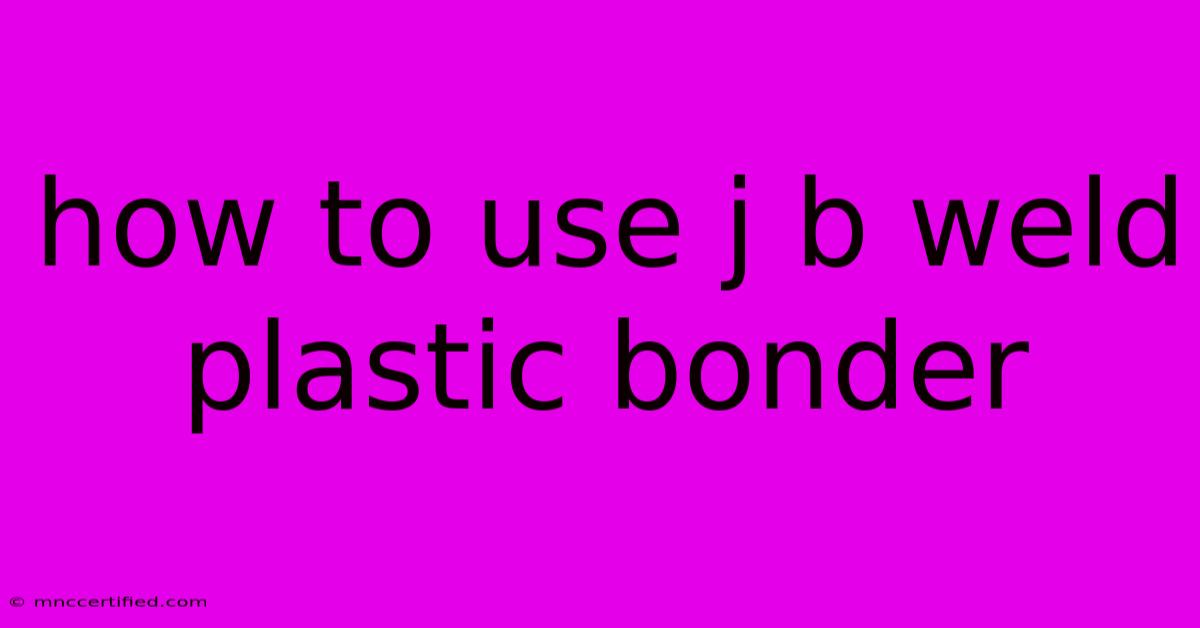How To Use J B Weld Plastic Bonder

Table of Contents
How to Use JB Weld Plastic Bonder: A Comprehensive Guide
JB Weld Plastic Bonder is a versatile, epoxy-based adhesive designed to repair and bond a wide range of plastics. Whether you're fixing a cracked phone case, a broken toy, or a damaged car part, this powerful adhesive can help you restore your belongings to their former glory. But using JB Weld Plastic Bonder effectively requires understanding the process. Let's delve into the steps to ensure a successful repair:
Preparing for the Repair
-
Gather Your Supplies: Before you begin, make sure you have everything you need:
- JB Weld Plastic Bonder: Choose the right formulation for your specific plastic type (refer to the product label for compatibility).
- Mixing Sticks or a Disposable Utensil: You'll need something to mix the adhesive.
- Protective Gloves: Epoxy can irritate the skin, so wear gloves for safety.
- A Clean Work Surface: This prevents dirt or debris from contaminating the adhesive.
- Paper Towels or Rags: For wiping spills and cleaning up.
- Optional: A small piece of sandpaper (for roughing up surfaces), a clamp (for holding parts together), and a scraper (for removing excess adhesive).
-
Clean the Surfaces: The success of your repair hinges on clean, dry surfaces.
- Remove any dirt, grease, oil, or residue: Use a cleaner suitable for the plastic type.
- Allow surfaces to dry completely: This prevents the adhesive from weakening.
-
Roughen the Surfaces (Optional): For stronger adhesion, lightly sand the areas you'll be bonding.
- Use fine-grit sandpaper (220 or higher): This creates a rough surface for the adhesive to grip onto.
- Wipe away dust and debris: Ensure the surfaces are clean before applying the adhesive.
Applying JB Weld Plastic Bonder
-
Mixing the Adhesive: Carefully follow the instructions on the product label.
- Mix equal parts of the resin and hardener: Use a mixing stick or disposable utensil.
- Thoroughly mix for 2-3 minutes: This ensures the adhesive is properly activated.
-
Applying the Adhesive:
- Apply a thin, even layer to both surfaces: Don't overload the surfaces.
- Press the surfaces together firmly: Apply pressure for at least 30 seconds.
- Use a clamp if necessary: This helps ensure a secure bond.
-
Curing Time: The time it takes for JB Weld Plastic Bonder to fully cure depends on the specific product and the ambient temperature.
- Allow the adhesive to cure according to the manufacturer's instructions: This usually takes 24 hours or more.
- Avoid exposing the repair to direct sunlight or heat: This can affect the curing process.
Tips for Success
- Use a small amount of adhesive: It's better to use too little than too much. Excess adhesive can weaken the bond.
- Work in a well-ventilated area: The fumes from the adhesive can be irritating.
- Clean up spills immediately: Epoxy can stain surfaces, so wipe up spills quickly.
- Test on a hidden area first: This helps ensure the adhesive is compatible with your plastic type.
Troubleshooting Common Issues
- Adhesive won't bond: This could be due to dirty surfaces, improper mixing, or an incompatible plastic type.
- Bond is weak: The adhesive may not have cured properly, or you may not have applied enough pressure.
- Adhesive is runny: This could be due to improper mixing or excessive heat.
Conclusion
JB Weld Plastic Bonder is a valuable tool for repairing and bonding plastic parts. By understanding the proper application techniques, following the manufacturer's instructions, and paying attention to important factors like surface preparation and curing time, you can ensure a successful and long-lasting repair. Remember to always prioritize safety and consult the product label for specific instructions and precautions.

Thank you for visiting our website wich cover about How To Use J B Weld Plastic Bonder. We hope the information provided has been useful to you. Feel free to contact us if you have any questions or need further assistance. See you next time and dont miss to bookmark.
Featured Posts
-
Roca Group Sap Drives Efficiency
Nov 15, 2024
-
Melhores Carteiras De Criptomoedas
Nov 15, 2024
-
Fast Sellout Glastonbury Tickets Gone In 30 Minutes
Nov 15, 2024
-
Circuits Of Value Price Prediction
Nov 15, 2024
-
Ector County Trading Post Odessa Tx
Nov 15, 2024